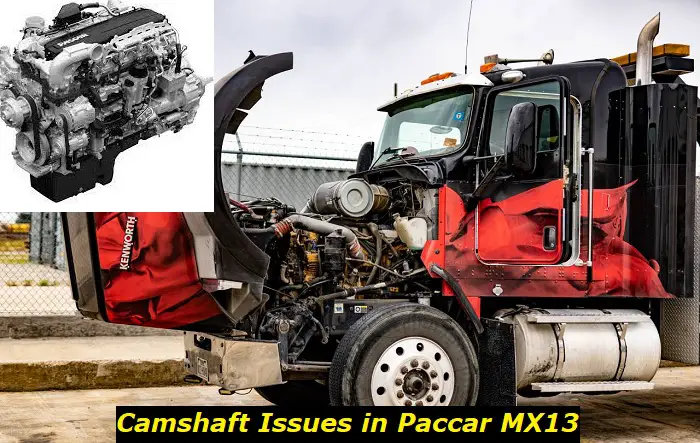Paccar MX 13 Camshaft Problems: Reasons, Symptoms, and Fixes
The Paccar MX-13 engine is designed and manufactured by PACCAR for use in trucks and other commercial service vehicles. PACCAR is a multi-national company based in Bellevue, Washington, USA, and is a reputed manufacturer of different commercial vehicles, buses, and trucks under different brand names including DAF, Kenworth, and Peterbilt. The company has been in operation since 1905.

PACCAR engines are known for their high technology, fuel efficiency, and durability. They are used in various commercial fields including construction and long-haul trucking. The company also manufactures engines and other parts for all its vehicles.
The company has a series of inline engines which include:
- The PX-7
- The PX-9
- The PX-11
- The MX-11
- The MX-13
- The MX-15
- The Kenworth T680E
- The Peterbilt 579EV
The last two are hybrid powertrains.
In this article, we shall discuss the problems associated with the Paccar Mx-13 engine, the common symptoms, and how to fix the issues when they arise.
The Paccar MX-13 Engine
The Paccar MX-13 engine is one of the so-called PACCAR MX Series engines. The MX Series are medium to heavy-duty engines for use in buses, trucks, and several other heavy-duty commercial vehicles. The MX Series engines are common in regional haul trucks, vocational trucks, and many other road trucking applications. The series includes the MX-11, MX-13, and MX-15 engines.
The MX-13 is a 12.9-liter engine capable of churning out between 380 hp and 500hp.
The MX-13 engine uses innovative technology to enhance reliability, fuel economy, durability, and adherence to emissions protocols. The engine has a high power output with a corresponding fuel efficiency that significantly reduces operational costs to the owner.
The engine comes with a uniquely designed engine block that utilizes CGI (Compacted Granite Iron) technology. This technology enables the block to expand and contract without compromising its structural integrity. The CGI technology provides a magnificent horsepower-to-weight ratio for maximum power while greatly reducing noise output.
The Paccar MX-13 has a distinctive, lightweight, forged-steel camshaft that does not have the contra-weights. The light weight reduces drag and increases engine power for extra-fast acceleration and a very smooth operation. Additionally, the MX-13 engine has integrated lubrication and cooling systems that combine thermostats, oil coolers, and filters that jointly operate without external lines. This method maintains oil quality which increases service intervals for the engine.
The Paccar MX-13 engine is quite durable with smooth, high-performance capabilities. About 90% of MX-13 engines clock above one million miles without requiring any major repair. However, the engine is prone to engine mishaps, one among them being camshaft issues. Below are some common problems related to the Paccar MX-13 camshafts that are likely to be encountered from time to time.
Problems, Symptoms, and Fixes
A camshaft, located in the cylinder head, controls and coordinates the opening and closing of the inlet and exhaust valves to complete the combustion cycles. The camshaft is connected to the crankshaft through a timing chain or belt and rotates at half the speed of the camshaft for precise timing and sequencing of each engine stroke.
The MX-13 camshaft has undergone various design changes to improve performance while increasing reliability and durability. The MX-13 camshaft has the following specs:
- Optimized main bearings' diameters
- Optimized connecting rods' diameters. This optimization enables the camshaft to distribute its performance load properly
- Additional counter-weights to reduce noise/vibrations
- Increased oil flow to provide extra lubrication for the rotating parts
- Optimized valves/valve-train to reduce loading
Common Symptoms
- Noisy Engine
Worn cam lobes increase valve clearance distances, making them noisy as they move up and down. Thus, a loud tapping noise emanating from the upper section of the MX-13 engine is an indicator that the cam is having issues.
- Misfiring Engine
A damaged camshaft will compromise the opening and closing of the valve timings for proper combustion. This means the ignition process of the air-fuel mixture will be random, causing a constant misfire and a loss of power from the engine.
- Excessive smoke
Related to misfiring due to camshaft issues, the engine is likely to produce excessive smoke as the air-fuel mixture does not fully combust. This un-combusted fuel is released through the exhaust pipe as dark/black smoke.
- Backfires
When the camshaft has issues, the combustion process may happen outside of the combustion chamber due to uncoordinated valve opening/closing timings. Thus, the air-fuel mixture ignites in the manifold or the exhaust pipe resulting in the backfire as the mixture explodes.
- Excessive Fuel Consumption
Since the camshaft controls the combustion process, a problematic cam will increase fuel consumption since the fuel ignition in the chamber is not precise. The fuel may fail to ignite properly or is ignited outside the chamber leading to a low engine power output and loss of fuel.
- Metal Debris in Oil
When the cam lobes become worn out, the worn metallic parts will contaminate the engine oil. The debris can only be visible when the oil is drained and checked. This metallic debris may cause other damage to the engine as it gets circulated by the oil.
- Visible Signs of Damage
Sometimes, when the cam is exposed during maintenance or repair, you may notice cracks, breakages, misalignment, or signs of wear both on the cam or the lobes.
- Check Engine Light
A problematic or failed cam will cause critical issues to the combustion and exhaust processes. These will send an error code to the ECU which then turns the Check Engine light on to alert you of the issue. You will need to use the diagnostic tool to get the problem.
Here are the common issues of the MX13 engine cam
1) Cracked/Broken Cam
A hard collision between the cam and the connecting rod may crack or break the cam. The collision may result from a crashed or misaligned valve or a compromised cylinder head (though this is a rare occurrence). A cracked/broken cam will not operate as expected.
2) Broken Dowell Pins
Dowell pins are used as markers for the right positioning of timing pulleys or sprockets for the camshaft. The two parts are held to the camshaft by bolts which if loose, allow the pulleys to move which breaks the pins. The camshaft rotates in an out-of-tune position leading to damages.
3) Failed Cam
The most common crankshaft problem is a failed camshaft. When it fails, it means the opening and closing of valves in the combustion cylinder will not occur as expected. This may lead to expensive engine damage.
4) Valve train damage
When coolant oil becomes contaminated, it may fail to lubricate the camshaft (and other moving engine parts) properly. This leads to high friction between the camshaft and the cylinder head or the crankshaft. As such, the valve train becomes damaged and the whole combustion process is jeopardized.
5) Premature Wear
Normally, an MX-13 camshaft is supposed to last the entire life of the engine. However, camshafts may wear prematurely due to poor lubrication of the camshaft lobes. When the lobes are not properly lubricated, there is a lot of friction between the camshaft and other parts, resulting in quick wear of the cam. A wear of even 0.001 inches is too much for the cam.
What are the most common reasons for cam failure?
Camshaft failures and issues may be caused by:
- Pitting of cam lobes. Due to continuous rolling of the lobes, some parts may wear off from the surface leaving behind a scarred surface on the cam which affects movement and contaminates the lubricant with debris.
- Lack of proper lubrication. Causes friction which reduces movement and also causes wearing
- Use of wrong or poor-quality engine oil
- Wrongly installed camshaft. Results in uneven movement, uncontrolled valve opening and closing
- A faulty cam lifter. Leads destruction of valve tips, rocker arm, and push rod which severely affects cam operations
- A faulty camshaft position sensorleads to a loss of data transfer to the ECU. Hence a mismatch between fuel delivery and ignition will arise leading to a sputtering engine.
Fixes
It is not advisable to repair a faulty camshaft. However, depending on the extent of the lobe wear or damage, the cam can be rebuilt. If the wear is very minor and resembles just a scratch, the cam can then be rebuilt either through welding or regrinding.
When a camshaft fails, it should be replaced with a new one. It is important to remember that a cam should be replaced by an expert and all the necessary procedures strictly followed to ensure the new cam fits and runs smoothly to prevent engine damage due to improper fitting.
Apart from installing new lifters and lobes with the new cam, a thorough inspection of other parts should be carried out to rectify the components that may be affecting the cam operations. New engine oil should also be added with a new cam.
The break-in process might be necessary when installing a new cam. Ensure the manufacturer's instructions are strictly followed in every stage of installation.
Clear all the pathways, ducts, and drillings and ensure every part is spotless-clean before installing the new camshaft.

Add comment